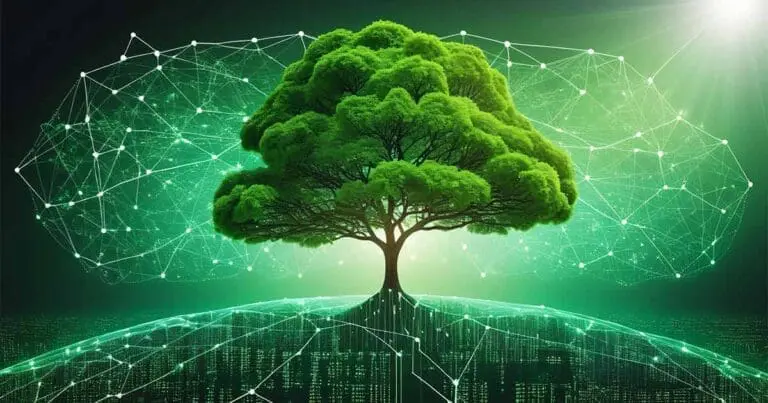Green Tech: 5 Sustainability Innovations in the Tech Sector

The tech industry, vital for global progression, faces increasing scrutiny over its environmental footprint, encompassing energy consumption, e-waste, and resource depletion.
Recognizing this, sustainable innovations have emerged as critical pathways toward reducing the ecological impacts of technology, aiming for a balance between technological advancement and environmental stewardship.
These initiatives foster the development of eco-friendly products and processes, setting the stage for a greener, more sustainable future.
What is green tech?
Green tech, or sustainable tech, refers to the design, manufacturing, and use of technology in a manner that significantly reduces its environmental impact.
It encompasses innovations that improve energy efficiency, minimize waste, and promote the use of renewable resources.
The goal of sustainable tech is not only to meet current technological needs but to do so in a way that preserves the environment for future generations.
The environmental footprint of the tech industry
The environmental footprint of the tech industry involves measuring energy consumption, e-waste, resource depletion, and greenhouse gas emissions.
Energy consumption in the tech industry
The tech industry is among the largest consumers of energy worldwide, primarily due to the operation of data centers, which are the backbone of internet services, cloud computing, and global communications.
To mitigate this, companies are increasingly investing in renewable energy sources and designing more energy-efficient data centers.
This shift not only reduces the industry’s carbon footprint but also paves the way for a more sustainable digital infrastructure.
E-waste in the tech industry
E-waste, or electronic waste, represents a significant environmental challenge, with millions of tons of obsolete electronics ending up in landfills every year.
Efforts to address this issue include developing recycling programs and designing products for easier disassembly at the end of their lifecycle.
These approaches aim to reclaim valuable materials and reduce the ecological damage caused by e-waste.
Resource depletion in the tech industry
The extraction of metals and other materials needed for technology production also contributes to resource depletion, affecting ecosystems and communities worldwide.
To combat this, some companies are exploring sustainable extraction methods and increasing their reliance on recycled materials.
Beyond these measures, there’s a growing emphasis on developing technologies that are not only efficient in their use but also in their impact on the planet’s natural reserves.
Greenhouse gas emissions caused by the tech industry
The tech sector’s environmental impact is notably significant, contributing to 2 to 3% of global greenhouse gas emissions.
Specifically, the energy consumed by data centers for Bitcoin mining accounted for up to 0.3% of the world’s electricity in 2019, a figure equivalent to the total electricity consumption of Belgium.
This underscores the urgent need for the industry to adopt more sustainable practices to mitigate its impact on climate change.
Green and sustainable tech innovations
Green and sustainable tech innovations include renewable energy sources, energy-efficient data centers, sustainable materials, eco-friendly transportation, and digital technologies.
1. Renewable energy sources
Renewable energy sources, such as solar, wind, and hydroelectric power, are becoming integral to powering the tech industry sustainably.
By harnessing these clean energy forms, technology companies can significantly reduce their carbon emissions and make a positive impact on the environment.
This transition not only aligns with global sustainability goals but also sets a precedent for innovation in energy efficiency within the sector.
2. Energy-efficient data centers
Energy-efficient data centers represent a pivotal innovation, leveraging advanced cooling technologies and energy management systems to lower power consumption.
These technologies not only curtail the operational carbon footprint but also offer significant cost savings over time.
Furthermore, the adoption of modular data center designs allows for scalability with minimal environmental impact, illustrating a sustainable growth pathway for the tech industry.
3. Sustainable materials
The shift towards sustainable materials in the tech industry marks a critical step in minimizing the environmental impact of products throughout their lifecycle.
Manufacturers are increasingly integrating biodegradable or recycled materials into devices, from packaging to the devices themselves, aiming to reduce waste and conserve resources.
This approach not only promotes environmental sustainability but also encourages innovation in material science, leading to the development of new, eco-friendly alternatives.
4. Eco-friendly transportation
In the realm of eco-friendly transportation, advancements are being made in electric vehicles (EVs) and sustainable urban mobility solutions.
These innovations aim to reduce reliance on fossil fuels and decrease urban pollution levels, enhancing the quality of life in densely populated areas.
Companies within the tech industry are also exploring ways to use technology to optimize transportation routes and improve the efficiency of public transit systems, contributing further to the reduction of the sector’s environmental impact.
5. Digital technologies
Digital technologies have the potential to significantly reduce the world’s carbon emissions by up to 17%, through innovative applications of AI in optimizing electric grids and satellites in continuously monitoring environmental changes.
The integration of AI ensures that electric grids operate at peak efficiency, minimizing waste.
Meanwhile, blockchain technology offers a reliable and transparent method for tracking emissions, facilitating greater accountability across industries.
Tech company sustainability initiatives
Tech company sustainability initiatives include recycling programs, sustainable supply chain management, and carbon offsetting.
Tech company recycling programs
With pressure to develop greener practices, tech companies are increasingly developing comprehensive recycling programs aimed at reducing the environmental impact of e-waste.
These initiatives encourage consumers to return used electronics, which are then properly dismantled for recycling, keeping harmful materials out of landfills.
Programs like these not only contribute to environmental sustainability but also promote a circular economy in the technology sector.
Sustainable supply chain management
Sustainable supply chain management in the tech industry focuses on minimizing environmental harm while maximizing resource efficiency.
This involves adopting practices such as ethical sourcing of raw materials, reducing transportation emissions through better logistics, and investing in the sustainability of the suppliers.
These efforts ensure that the production and distribution of technology products contribute positively to environmental conservation and sustainable development.
Carbon offsetting in the tech industry
Carbon offsetting has become a critical strategy for tech companies aiming to achieve net-zero emissions, involving the investment in environmental projects to counterbalance their own carbon footprint.
These projects often include reforestation efforts, development of renewable energy facilities, and carbon capture technologies.
By prioritizing carbon offset initiatives, the tech industry demonstrates its commitment to combatting climate change and fostering a more sustainable future.
The role of AI and machine learning in sustainability
The role of AI and machine learning in sustainability involves, AI energy management, predictive maintenance, and machine learning models for optimization.
AI energy management
Artificial Intelligence (AI) and machine learning have emerged as powerful tools for optimizing energy management systems, enabling more efficient use of resources.
By analyzing data patterns and predicting energy needs, these technologies can automate adjustments to consumption, significantly reducing waste and operational costs.
This strategic application of AI not only enhances sustainability efforts but also propels the tech industry toward a more eco-conscious future.
Predictive maintenance
Predictive maintenance, empowered by AI and machine learning, has revolutionized the way we manage and maintain industrial equipment, leading to reduced energy consumption and extended asset life.
By accurately predicting when maintenance is needed, companies can avoid unnecessary checks and downtime, thereby saving resources and reducing their environmental footprint.
This not only contributes to sustainability but also to significant cost savings, showcasing a prime example of technology working hand in hand with ecological conservation.
Machine learning models for optimization
Machine learning models are instrumental in the optimization of various processes across industries, not just in technology.
By learning from vast datasets, these models can identify patterns and make decisions that humans might not quickly discern, thereby optimizing operational efficiency and reducing waste.
This capability is especially crucial in logistics and manufacturing, where it can lead to significant reductions in energy use and carbon emissions.
Challenges and controversies in green tech
Challenges and controversies in green tech include greenwashing, the cost of green technologies, and the digital divide.
Greenwashing in tech
While tech companies increasingly publicize their commitment to sustainability, accusations of greenwashing have surfaced, casting doubts on the authenticity of their claims.
Critics argue that some initiatives are more about marketing than making a real environmental impact, with reports suggesting that actual investments in green technologies are not as substantial as portrayed.
This scenario highlights the need for greater transparency and accountability in the tech industry’s sustainability efforts.
The cost of green technologies
Despite the clear environmental benefits, the adoption of green technologies often comes with higher upfront costs, deterring widespread implementation.
However, long-term savings in operational expenses and the potential for government incentives can offset these initial investments. Consequently, a broader understanding and appreciation of the economic feasibility of green technologies are crucial for their accelerated adoption.
The digital divide
The digital divide is a significant challenge for global sustainability as it makes it harder for everyone to have equitable access to the technology and information they need.
Efforts to bridge this divide are essential for ensuring that the benefits of green technologies and sustainable practices are accessible to all, irrespective of geographic or socio-economic status.
This inclusivity is key to fostering a truly sustainable future, where everyone can participate in and benefit from technological advancements.
The future of green tech and tech sustainability
Sustainable innovations in the tech industry play a crucial role in promoting environmental health by reducing waste, lowering emissions, and conserving resources.
These green technologies not only pave the way for a healthier planet but also ensure a sustainable future for subsequent generations.
It is imperative for companies, consumers, and policymakers to champion and invest in these sustainable practices and technologies.
By working collaboratively, we can accelerate the transition towards a more eco-friendly and technologically advanced society.
Looking to hire top-tier Tech, Digital Marketing, or Creative Talent? We can help.
Every year, Mondo helps to fill over 2,000 open positions nationwide.
More Reading…
- Top 6 Job Search Tips During Layoffs
- How to Write an ATS-Friendly Resume in 2024
- Unionized College Athletes: Dartmouth Sets a Precedent for Change
- Quantifying a Project Manager’s Success to Advocate for Hiring
- Breaking the Code: How Women are Shaping the Future of Cybersecurity
- The Rise of AI Majors: Transforming the US Job Market
- The Tech Layoff Boom: Shifts and Opportunities
- Quantum Computing Explained: Preparing for the Jobs of Tomorrow
- Beyond the Hype: The Current State of Generative AI and its Hurdles
- Tips to Leverage Your Onboarding Process for Employee Retention
- Pay Transparency: What States Have It & Why It’s Important
- 10 Tech Jobs That Saw the Highest Salary Growth This Year
- Highest Paid Data Science Roles & Top Salaries



